Thegrader
On this page, you find all documents, package deals, and flashcards offered by seller THEGRADER.
- 661
- 0
- 0
Community
- Followers
- Following
661 items

PSY 101 FINAL EXAM| STRAIGHTERLINE
PSY 101 FINAL EXAM| STRAIGHTERLINE1. History, Research Methods, and Testing (10% to 14%) A. History and Theoretical Approaches Recommended Study Resources: 1) Chapter One Introduction to Psychology - Nature of the Conscious Experience, Nature of the Unconscious Mind, Visual Review of Historical Timeline 2) Moodle Course Topic 1: The History of Science in Psychology B. Types of Research and Research Designs Recommended Study Resources: 1) Chapter 2: Research methods in Psychology, Research...
- Exam (elaborations)
- • 9 pages •
PSY 101 FINAL EXAM| STRAIGHTERLINE1. History, Research Methods, and Testing (10% to 14%) A. History and Theoretical Approaches Recommended Study Resources: 1) Chapter One Introduction to Psychology - Nature of the Conscious Experience, Nature of the Unconscious Mind, Visual Review of Historical Timeline 2) Moodle Course Topic 1: The History of Science in Psychology B. Types of Research and Research Designs Recommended Study Resources: 1) Chapter 2: Research methods in Psychology, Research...

INTRO TO PSYCHOLOGY MILESTONE 1.
INTRO TO PSYCHOLOGY MILESTONE 1.
- Exam (elaborations)
- • 8 pages •
INTRO TO PSYCHOLOGY MILESTONE 1.

MED SURG EXAM 3.
MED SURG EXAM 3.Chapter 25 Assessment Respiratory System 1. The key anatomic landmark that separates the upper respiratory tract from the lower respiratory tract is the a. carina. b. larynx. c. trachea. d. epiglottis. Rationale: The carina is the anatomic landmark that separates the upper respiratory tract from the lower respiratory tract. The larynx, epiglottis, and trachea are all above the carina (part of the upper respiratory tract). 2. A patient asks, “How does air get into my ...
- Exam (elaborations)
- • 74 pages •
MED SURG EXAM 3.Chapter 25 Assessment Respiratory System 1. The key anatomic landmark that separates the upper respiratory tract from the lower respiratory tract is the a. carina. b. larynx. c. trachea. d. epiglottis. Rationale: The carina is the anatomic landmark that separates the upper respiratory tract from the lower respiratory tract. The larynx, epiglottis, and trachea are all above the carina (part of the upper respiratory tract). 2. A patient asks, “How does air get into my ...

MEDSURG:HESI PACKET.
MEDSURG:HESI PACKET.1. Stool that is narrower in diameter, (ribbon like) can be an indication of left sided colon cancer. 2. Colonoscopy every 10 years, starting at age 50, for everyone at average risk to screen for colorectal cancer. 3. 2 Liters of polyethylene glycol (GoLYTELY) solution; is a saline and osmotic laxative solution that causes retention of fluid in the intestinal lumen from the osmotic effect. Its purpose is to clean out all feces from the colon. By the end of the preparation, ...
- Exam (elaborations)
- • 14 pages •
MEDSURG:HESI PACKET.1. Stool that is narrower in diameter, (ribbon like) can be an indication of left sided colon cancer. 2. Colonoscopy every 10 years, starting at age 50, for everyone at average risk to screen for colorectal cancer. 3. 2 Liters of polyethylene glycol (GoLYTELY) solution; is a saline and osmotic laxative solution that causes retention of fluid in the intestinal lumen from the osmotic effect. Its purpose is to clean out all feces from the colon. By the end of the preparation, ...

GE 350 PROFESSIONAL COMMUNICATION CULTURAL SENSITIVITY.
GE 350 PROFESSIONAL COMMUNICATION CULTURAL SENSITIVITY.
- Exam (elaborations)
- • 7 pages •
GE 350 PROFESSIONAL COMMUNICATION CULTURAL SENSITIVITY.
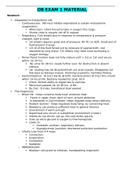
OB EXAM 1 MATERIAL
OB EXAM 1 MATERIAL• Adaptation to Extrauterine Life o Cardiovascular: NB must initiate respirations & sustain extrauterine oxygenation When born, infant forced to take in oxygen thru lungs. Shunts close & vessels clot off & regress o Respiratory: First breath also in response to temperature & pressure changes, light & noise. 1st breath requires great pressure; 40-70 cm H2O. Small amt of fluid present in lungs. 1/3 rd of this fluid forced out by pressure of vaginal ...
- Exam (elaborations)
- • 36 pages •
OB EXAM 1 MATERIAL• Adaptation to Extrauterine Life o Cardiovascular: NB must initiate respirations & sustain extrauterine oxygenation When born, infant forced to take in oxygen thru lungs. Shunts close & vessels clot off & regress o Respiratory: First breath also in response to temperature & pressure changes, light & noise. 1st breath requires great pressure; 40-70 cm H2O. Small amt of fluid present in lungs. 1/3 rd of this fluid forced out by pressure of vaginal ...
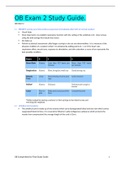
OB Exam 2 Study Guide.
OB Exam 2 Study Guide.PRIORITY nursing care/interventions/assessment immediately after birth of normal newborn Check Vitals Most important is to establish respiratory function with the cutting of the umbilical cord. (clear airway using the bulb syringe first mouth then nose) Dry baby up Perform a physical assessment called Apgar scoring to rule out any abnormalities. It is a measure of the physical condition of a newborn infant. It is obtained by adding points (2, 1, or 0) f...
- Exam (elaborations)
- • 15 pages •
OB Exam 2 Study Guide.PRIORITY nursing care/interventions/assessment immediately after birth of normal newborn Check Vitals Most important is to establish respiratory function with the cutting of the umbilical cord. (clear airway using the bulb syringe first mouth then nose) Dry baby up Perform a physical assessment called Apgar scoring to rule out any abnormalities. It is a measure of the physical condition of a newborn infant. It is obtained by adding points (2, 1, or 0) f...
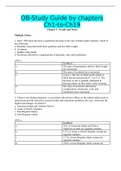
OB-Study Guide by chapters Ch1-to-Ch19
OB-Study Guide by chapters Ch1-to-Ch19Multiple Choice 1. Since 1995 there has been a significant decrease in the rate of infant death related to which of the following: a. Disorders associated with short gestation and low birth weight b. Accidents c. Sudden infant death d. Newborns affected by complications of placenta, cord, and membranes ANS: c Feedback a. The rates of prematurity and low birth weight are increasing. b. The rates of accidents have increased. c. Correct. The rate...
- Exam (elaborations)
- • 200 pages •
OB-Study Guide by chapters Ch1-to-Ch19Multiple Choice 1. Since 1995 there has been a significant decrease in the rate of infant death related to which of the following: a. Disorders associated with short gestation and low birth weight b. Accidents c. Sudden infant death d. Newborns affected by complications of placenta, cord, and membranes ANS: c Feedback a. The rates of prematurity and low birth weight are increasing. b. The rates of accidents have increased. c. Correct. The rate...
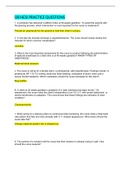
OB HESI PRACTICE QUESTIONS
OB HESI PRACTICE QUESTIONSA primipara has delivered a stillborn fetus at 30-weeks gestation. To assist the parents with the grieving process, which intervention is most important for the nurse to implement? Provide an opportunity for the parents to hold their infant in privacy 2. A one-day-old neonate develops a cephalhematoma. The nurse should closely assess this neonate for which common complication? Jaundice 3. What is the most important assessment for the nurse to conduct followi...
- Exam (elaborations)
- • 6 pages •
OB HESI PRACTICE QUESTIONSA primipara has delivered a stillborn fetus at 30-weeks gestation. To assist the parents with the grieving process, which intervention is most important for the nurse to implement? Provide an opportunity for the parents to hold their infant in privacy 2. A one-day-old neonate develops a cephalhematoma. The nurse should closely assess this neonate for which common complication? Jaundice 3. What is the most important assessment for the nurse to conduct followi...
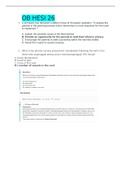
OB HESI 26| GRADED A+
OB HESI 261. A primipara has delivered a stillborn fetus at 30-weeks’ gestation. To assess the parents in the grieving process which intervention is most important for the nurse to implement ? A. explain the possible cause of the fetal demise B. Provide an opportunity for the parents to hold their infant in privacy C. Encourage the parents to seek counseling within the next few weeks D. Assist the couple to request autopsy 2. What is the priority nursing assessment immediately follo...
- Exam (elaborations)
- • 6 pages •
OB HESI 261. A primipara has delivered a stillborn fetus at 30-weeks’ gestation. To assess the parents in the grieving process which intervention is most important for the nurse to implement ? A. explain the possible cause of the fetal demise B. Provide an opportunity for the parents to hold their infant in privacy C. Encourage the parents to seek counseling within the next few weeks D. Assist the couple to request autopsy 2. What is the priority nursing assessment immediately follo...
